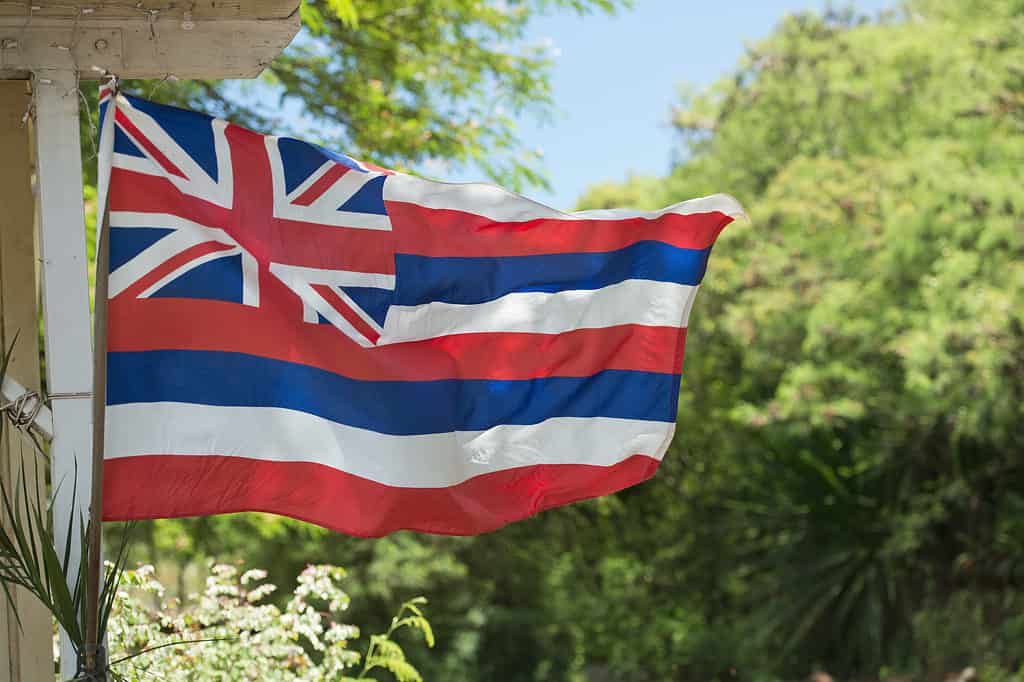The flag of the state of Hawaii is a simple and beautiful design that features eight alternating stripes of white, red and blue, with a blue canton in the upper left corner. In the center of the blue canton is the Union Jack of the United Kingdom, representing Hawaii’s historical ties to Britain. Its official name is “Ka Hae Hawai’i” which literally translates to “the flag of Hawaii.”
Hawaii’s flag symbolizes the state’s rich history and unique identity as a melting pot of different cultures. It also symbolizes the state’s vibrant spirit and its proud people. Take a trip back in time with us as we uncover the history, meaning, and symbolism behind one of our favorite flags: The Flag of Hawaii.
History Of Hawaii
Hawaii is a group of 137 islands (8 major) located in the Pacific Ocean, about 2,000 miles from the mainland United States. It is also the most recent state added to the United States, being officially annexed in 1959. The islands have a rich and fascinating history that dates back hundreds of years.
Arrival Of Polynesian Settlers
The history of Hawaii is full of culture and traditions that inspire its people to this day. The first Polynesian settlers arrived on the islands around 400 A.D., bringing their seafaring skills and deep knowledge of plants and fish that formed the foundations for early Hawaiian civilization.
For hundreds of years, gods were worshipped, monuments were built, trading networks flourished, and this unique native culture developed. Over time, the Hawaiian people developed a complex system of government and social hierarchy, with powerful rulers and a highly organized society.
British, American, And French Presence In Hawaii
In the late 1700s and early 1800s, Hawaii came into contact with the Western world. British and American traders began to visit the islands. In 1778, British explorer Captain James Cook became the first European to make contact with the Hawaiian people.
Hawaii joined the British Empire voluntarily in 1784. The Pacific archipelago was under the control of Kamehameha I, but he acknowledged King George III as emperor. Hawaii, however, was becoming more influenced by the United States and its Protestant missionaries.
On 30 March 1820, American missionaries arrived in Hawaii and began establishing schools and churches. This led to a significant change in Hawaiian society, as many Hawaiians converted to Christianity and adopted Western ways of life.
During the Paulet affair, also known as British Hawaii, British naval officer Captain Lord George Paulet of HMS Carysfort unofficially occupied the Hawaiian Islands for five months in 1843. However, the American warships ended the occupation by defending Hawaiian independence.
The Hawaiian Kingdom’s capital Honolulu was invaded by the French admiral Louis Tromelin in 1849 as retaliation for the persecution of Catholics and the repression of French trade. This attack is referred to as the Sacking of Honolulu or the Tromelin Affair.
On 16 January 1893, soldiers of the United States invaded Hawaii, staging an illegal coup. Just a day after the invasion, the Hawaiian Kingdom’s executive monarch, Her Majesty Queen Lili’uokalani, surrendered on a conditional basis, making her the last sovereign monarch of the Hawaiian Kingdom.
In 1959, the United States welcomed Hawaii into the union as its 50th state. However, Hawaii had been a territory of the United States since 1898 and was annexed following a vote by the Hawaiian Congress in 1900, but it didn’t become an official state until fifty-nine years later.
This meant that citizens of all Hawaiian Islands officially became Americans with all of the privileges and responsibilities associated with American citizenship. Since then, Hawaii has had an illustrious history of representation at each level of the US government, including the Oval Office, as President Barack Obama was from the state.

Hawaii became the 50th state of the United States of America in 1959.
©iStock.com/maximkabb
History Of The Flag Of Hawaii
After visiting the islands with Captain James Cook in 1778-1779, Captain George Vancouver returned as commander of HMS Discovery in 1793. Vancouver presented a Red Ensign, used by the Royal Navy at the time, to Kamehameha I (first ruler of the kingdom of Hawaii) during the visit.
It is important to note that the Saint Patrick’s Cross of Ireland was not part of the British flag before 1801 since the Kingdom of Ireland was not yet formally part of the United Kingdom. In 1801, Saint Patrick’s Cross was added to the current Red Ensign, which served as the unofficial flag of the Kingdom of Hawaii until 1816. In that year, Western advisers to the king recommended adding red, white, and blue stripes to the Union Jack, thus creating the United Kingdom’s distinctive national flag.
Shortly after the unofficial short British occupation in 1843, King Kamehameha III set the number of stripes on the national flag at eight, with the stripes alternating colors of white, red, and blue. This flag is still used today. Several other flags were present at that time in Hawaii, including a royal standard, a naval ensign, and a jack.
As a result of the overthrow of the Hawaiian government in January 1893, the Stars and Stripes of the United States were hoisted alongside the official Hawaiian regional flag. In 1894, Hawaii’s new leaders proclaimed Hawaii a republic under its former national flag after being rejected in their attempt to gain annexation by the United States. Hawaii, however, became a United States territory in 1898, and the region and state adopted the same flag, unchanged, of the former kingdom and republic.

King Kamehameha III set the number of stripes on the national flag.
©Alfred Thomas Agate, Public domain, via Wikimedia Commons – License
Symbolism In The Hawaiian Flag
Hawaii is the only U.S. state to include the flag of another country in its flag. The Royal Navy’s history of relations with the Hawaiian Kingdom, particularly with King Kamehameha I, is evident in the inclusion of the Union Jack of the United Kingdom.
There are eight horizontal stripes on the Hawaiian flag, symbolic of the eight main islands (Hawaiʻi, Kaua’i, Kahoʻolawe, Lānaʻi, Molokaʻi, Oʻahu, Maui, and Niʻihau). There are also versions of the flag with only seven stripes, probably representing all the islands except Ni’ihau or Kahoʻolawe.
There are two theories out there about the colors used in the flag.
- The red stripes represent the Hawaiian gods, the white represents truth, and the blue represents the ocean surrounding Hawaii.
- The second theory is that the red, white, and blue colors come from Britain, America, and France, which were all vying for control of Hawaii during its history.

The flag of Hawaii has eight horizontal stripes symbolizing the eight main islands.
©iStock.com/Andrea Izzotti
In addition to this symbolism, the Hawaiian flag also holds a broader significance as a symbol of Hawaii’s sovereignty and independence. The flag represents the unique identity and culture of the Hawaiian people and their struggle to maintain their autonomy and self-determination in the face of outside influences.
In the 1960s, 1970s, and 1980s there was also a growing movement for Hawaiian independence. The main symbol of this movement was an upside-down version of the current Hawaiian flag. This was to symbolize that the indigenous Hawaiians were unhappy with the way in which they came to be a US State and demanded better representation, recognition, and a formal apology for the illegal overthrow of the Hawaiian monarchy. While tensions are not nearly as high as they were at this time, there has yet to be a conclusion to these demands besides a formal apology and recognition that the occupation of Hawaii was illegal by the US government.
Click here to learn about every single flag in the world!
Up Next
- The Flag of Uruguay: History, Meaning, and Symbolism: Get to know the history, meaning, and symbolism behind the flag of Uruguay!
- Are There Monkeys In Hawaii?: Hawaii is famous for its flora, and due to its lush vegetation, one might assume the islands are home to a great many monkeys as well. But surprisingly, Hawaii does not have any monkeys. Find out why!
- The Longest Biking Trail in Hawaii: Hawaii features some beautiful landscapes that you can bike around. Discover the longest biking trail in the state!
The photo featured at the top of this post is © iStock.com/Milos Subasic
Sources
- Britannica, Available here: https://www.britannica.com/place/Hawaii-state
- Hawaii Magazine, Available here: https://www.hawaiimagazine.com/whats-the-story-behind-hawaiis-flag/
- Surfer Today, Available here: https://www.surfertoday.com/surfing/the-meaning-behind-the-hawaiian-flag
Thank you for reading! Have some feedback for us? Contact the AZ Animals editorial team.






